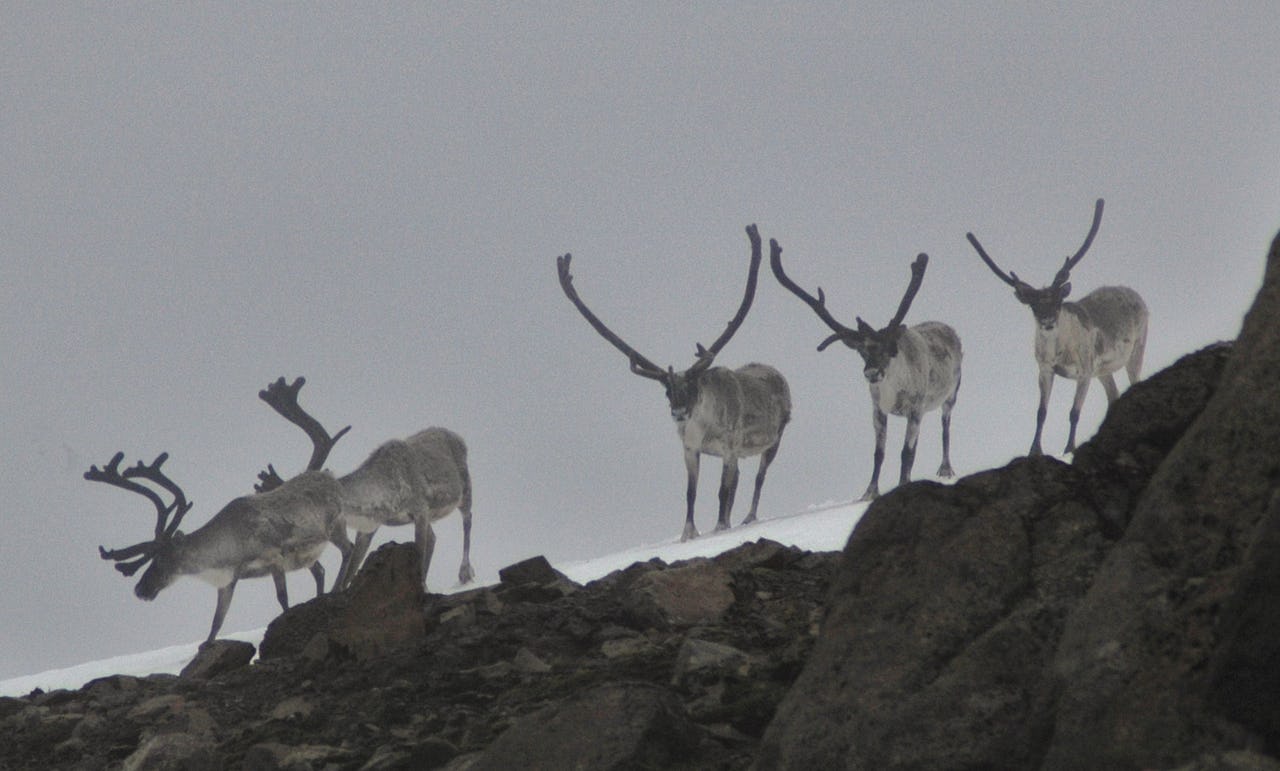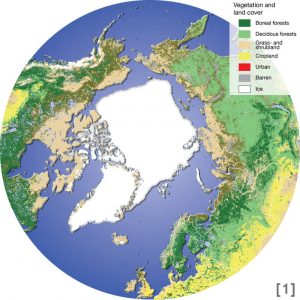Perspectives on the Evidence and Impacts of Changing Environments in the Far North

Seyðisfjörður – Reindeer In Mist. Photo: Nigel Nudds Photography
In viewing the wide range of issues in the context of the Arctic, we are witnessing the juxtaposition between choices and dilemmas, brought about not only by climate change, but also by the increasing frequency of economic crises. Melting of polar ice, as symbolized by the opening of the Northwest Passage, has made the scramble to exploit its abundant riches a very real quest. However, pursuits of rushed short-term investment opportunities that permanently alter the lives of the Arctic’s indigenous populations who have done nothing to cause those changes amount to an unethical equation that has multiple and complex ramifications for all of us. Legitimate and effective policies need to take into account the interests, values and knowledge of the people directly affected by them.
As the interdependence of polar and global ecosystems is now incontrovertible, the ultimate destiny of the Arctic must be viewed as an international issue. We now recognize that the extreme changes in the Far North have the potential of inducing severe and cumulative impacts on the entire planet. Growing demands for resources in other parts of the world put regions that are the lifeblood of indigenous peoples and animals at risk as the result of exploitation, industrial development, pollution and territorial claims. Political tensions between sovereign states exacerbate the problems, and there is deep concern that such preoccupations can overrule respect for the rights and welfare of the indigenous peoples.
Scientific field research and collected testimonies from numerous native communities reveal that in recent years, the weather across the entire Far North is uggianaqtuq (an Inuktitut word meaning “behaving erratically”). Wisely, these witness accounts are slowly being integrated into the larger body of polar research, which may help policymakers better comprehend the significant distinctions between and consequences of classifying the Arctic as “wilderness,” “frontier” or “home” in geopolitical terms, each of which is a valid categorization to different sectors of society.
Since the Inuit, Saami, Dolgans, and all other northern peoples are on the frontlines of climate change, their traditional knowledge, their social, cultural, human rights as well as related biological diversity are particularly vulnerable. However, it is more the magnitude and amplified rate than the changes themselves with which these groups struggle to stay in step.
Stable sea ice has been appearing later in the year and melts earlier, shortening the hunting season considerably. In areas where hunters have been unable to harvest sufficient numbers of seals, walruses and bears, they have been forced to shoot entire teams of sled dogs because the hunters cannot sustain them. In Sapmi, the region inhabited by the Saami people that stretches over northern Europe and Russia’s Kola Peninsula, Saami herders face their own problems. Climate-induced shifts in Arctic tundra vegetation have had a substantial impact on reindeer, which rely on proper foraging conditions to raise their young and maintain their populations. Erratic freeze-thaw cycles have further complicated the already stressed ecosystem. Reindeer, which normally dig through the snow to graze on lichen, are unable to break through the thick crust of ice that forms after rain falls during warm spells. Despite the fact that some reindeer have shown resilience by eating more during summer months, larger die-offs still occur due to these irregular cycles. To save their herds, some Saami herders have resorted to feeding their reindeer with fodder, which is expensive and not economically viable in the long term.
The unpredictability of weather patterns in conjunction with growing influences from the more industrialized world are also resulting in a loss of indigenous cultural identity. Even their native lexicon has had to adapt to the unprecedented changes in order to help these people communicate what they are witnessing. Words have had to be invented for previously unknown weather events and conditions, such as thunder and lightning or “ice rain,” or names coined for never before seen creatures such as wasps and robins that have recently migrated northward from more temperate zones.
Vegetation and land cover in the Arctic
Even more unusual phenomena are being recorded. As had been reported in mid January of 2011, for the first time in history, the sun rose over Greenland 48 hours ahead of its usual date of ending the six week long winter darkness. Although the mysterious sunrise initially confused scientists, the most likely explanation is that the melting ice expanses had lowered the horizon, allowing the sun’s rays to penetrate through two days earlier. If proven to be the case, this would indicate that climate change is accelerating dramatically.
While not all communities and ecosystems respond homogeneously, all residents of the Arctic will be forced to make lifestyle adjustments. Traditional knowledge is proving to be an essential skillset that plays a crucial role in this process.
Indigenous peoples are particularly well placed to observe environmental changes. Their attentiveness to the fluctuations and alterations in their natural surroundings are an integral part of their existence, and remain critically important even in areas where lifestyles have been modified by colonialism and globalization. Knowledge of specific localities often stretches back over many generations. When shared amongst elders and youth, this regional “history” provides the basis for valuable comparisons between conditions over long periods in the past and those being observed at present, thereby offering useful insights into local ecological transformation.
It is also important to keep in mind that indigenous populations have always been confronted with variability in their environments, which established the traditional methods by which to adapt to transitions in environmental, social and economic conditions, at local and regional levels. Their strategies for coping with these changes have allowed them to successfully negotiate historical shifts in the past by modifying existing practices and restructuring their relationships with the environment. Therefore, they should not be viewed simply as passive victims but as valuable partners in the global efforts to address the multidimensional issue.
Arctic native peoples have shown themselves to be incredibly innovative and flexible in the face of change, but in the contemporary and ever-changing world, adaptation alone is proving to be insufficient. Many indigenous groups have applied themselves to implementing new measures that will help them contend with the rapidly changing conditions in their respective territories. One such example is EALÁT, which together with the Association of World Reindeer Herders, engaged in a collaborative effort to produce the Reindeer Herders’ Vulnerability Network Study that focused on key challenges their ancient herding lifestyle must face. Through a series of working package projects, the teams proposed to both government and the private sector a series of policies, which will help sustain the viability of reindeer herding practices. Among them were recommendations to establish community-based monitoring of climate change in reindeer herding areas, facilitate the process of surveying and registration of pasture lands within each Arctic state, support transparency in infrastructure processes, and to avoid industrial development that could jeopardize reindeer herders’ ability to adapt and block or delay critical migrations between seasonal pastures.
Historically, reindeer herding communities across the Sapmi territory of northern Scandinavia and northwestern Russia have moved their lavvu tent-like structures with their herds across vast areas. Today, fewer Saami are able to follow that centuries-old lifestyle because many have been moved into permanent settlements. Additionally, their hunting and herding activities are now governed by land-use laws, landownership regulations, and resource management restrictions for projects like wind farms. Some Saami fear that it may be the present generation that will likely be the last to herd reindeer on their ancestral lands.
To address these concerns, some indigenous groups are forming coalitions such as the Saami Council, whose mission it is to promote Saami rights and interests, to attain recognition for the Saami as a nation and to maintain the economic, social and cultural rights of the Saami in the legislation of the four countries in which the Saami live: Norway, Sweden, Finland and Russia. As part of the Arctic Council Indigenous Peoples Secretariat, the Saami Council works in conjunction with five other Arctic indigenous organizations on parallel goals.
With support from UNESCO, native groups in the northern regions of Sapmi and Russia are creating a system of nomadic schools, which follow the routes of migrating reindeer. Such efforts keep family units intact while making education accessible for the herders’ children, who in the past were left behind in the settlements to attend conventional schools. Often run by members of the herder community, these mobile schools educate children in their natural surroundings, enabling the group to freely travel with their reindeer undisturbed. Projects like these also help to revitalize the culture of each respective indigenous group.
Even though we can expect that the ecological evolution precipitated by global changes will be unparalleled not just in the Arctic, but across the world, it is essential to forge agreements that incorporate indigenous perspectives and build on their expertise in relation to environmental stewardship. Even more importantly, we must include in any negotiations the protection of traditional property and rights, and allow indigenous societies to decide for themselves how to address the risks they face – all of which would facilitate productive collaboration in the pursuit of mutually beneficial objectives.
